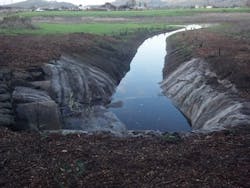About the author: John Hepfinger is global market manager for Milliken Infrastructure Solutions. Hepfinger can be reached at [email protected].
After years of extreme drought in the Pacific Coast town of San Luis Obispo, Calif., an anticipated El Niño season posed a significant threat to the city’s storm water infrastructure, main thoroughfares and wildlife. Due to the drought, the city already was facing flow issues in storm drains and needed to carefully rehabilitate them without creating erosion problems. In addition, maintaining state, county and city storm water quality requirements and minimizing long-term maintenance issues was an important consideration.
One double-barreled 48-in. culvert system in particular—originally designed to convey storm water from a nearby mountain range—was so impacted with sediment that the system was functioning at about 40% of design capacity. Rehabilitation efforts began by cleaning out the lower section of the culvert system and excavating the discharge basin. However, restoring the carrying capacity would cause the flow to impact a 4-ft exposed non-vegetated bank at the pipe’s output, creating the possibility of sediment pollution in nearby Laguna Lake, a critical habitat for steelhead trout.
San Luis Obispo City Biologist Freddy Otte worked with Robert Sjoquist, director of Soils Solutions, a local soil reclamation, erosion protection and retention company, to assess cost-effective solutions that would prevent bank failure and remain durable enough to withstand drought and flood conditions. They also were looking for a point source location from which to measure water quality and sediment loading.
Most applications fell short of meeting all the requirements. A shotcrete application on the bank would have had durability issues and quickly lost volume due to the high energy output from the water flow. Similarly, turf reinforcement mats (TRMs) would have needed more time to become secure on the bank in order to withstand even a fraction of the pipes’ anticipated flow. TRMs also would have required constant maintenance and irrigation, which was not feasible due to the drought. A poured-in-place concrete retaining wall was a more durable option but would have required extra expense to be engineered and code permitted before installation.
Excavation & Engineering
Sjoquist previously had used Milliken Infrastructure Solutions’ Concrete Cloth geosynthetic cementitious composite mats (GCCMs) and recommended the company’s thinnest solution—the ¼-in. CC5 GCCM—for the project. GCCMs are form-fitting, flexible concrete-impregnated fabrics that harden on hydration to form a thin, durable, waterproof and fire-resistant concrete layer, ideal for berm protection jobs such as this one.
Otte, Sjoquist and an another team member retrofitted the entire site—approximately 1,200 sq ft—in less than six hours using one bulk roll of the material. Strips of GCCM were cut to appropriate length using box cutters, laid out in a fan pattern and secured to the bank using simple decking screws. After hydrating the material, native California blackberry, arroyo willow and other wetland species were planted around the top of the bank to enhance aesthetics without impacting structural integrity.
The team also built a sediment catch basin to help quantify the pollutant loading at the site as part of the city’s storm water program. GCCMs again were deployed to create an even, impervious layer for the metering basin and draped over sandbags to form a downside lip.
A poured-in-place concrete wall would have required a building permit to install and also would have been challenging to build, with limited visibility below standing water during the pouring phase. Although the team hit groundwater during excavation, it still was able to dig approximately a foot down to begin building a containment basin in order to quantify sediment volume in the area.
Otte and Sjoquist’s on-the-fly engineering enabled the wastewater collection team to determine how much sediment is coming through the pipe and develop best management practices to correct any problems upstream.
“The potential for flooding in areas with heavy sediment is huge,” Otte said. “The metering basin is easy to clean out after each season or rain event, especially compared to a poured-in-place basin that can face volume loss and other expensive issues.”
Repeating Success
The path of the flow led the water directly into the embankment, and then out into the adjacent field at a 90-degree angle. Despite the excavations in the culvert system, Otte and Sjoquist were able to minimize vegetation removal in the area. As a result, the new outlet channel has been able to follow the same curve and sheet flow into the field.
Even during smaller rain events, both the berm application and catch basin have functioned well.
Otte will use the material in other applications as part of the city’s Program Effectiveness Assessment Improvement Plan to quantify pollutant loading at different locations around the city.
Through this outfall monitoring program, Otte and his team first evaluate storm drain outlets and identify hot spots for potential sediment problems. The team then takes samples from those areas, determines what kind of pollutant loading exists and calculates how much sediment is coming through the pipe by measuring the volume in the metering basin.
“From a functionality and cost perspective, this material integrated and was ideal because it did not need to be designed, engineered or inspected prior to installation,” Otte said. “The uses for this material far exceed just this one application. In fact, our team sees applicability all over town, even beyond what we have used it for in this project.”
Download: Here


